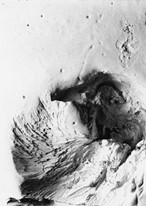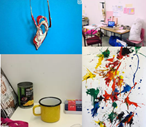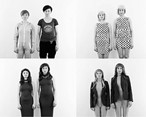Programme Overview
In the Department of Fashion and Textiles at The Glasgow School of Art you will find an international community of around 150 students at both undergraduate and postgraduate level.
Textile Design is concerned with the design of cloth for Interiors and Fashion. There are two broad areas of Textile Design known as ‘Structure’ and ‘Surface’. Structural Textiles include woven and knitted textiles where the structure and pattern of the cloth is formed from and by using yarn or thread. Surface Textiles include printed and embroidered textiles where pattern and interest is applied to the surface of an existing cloth using a variety of methods and processes.
The programme aims to create highly specialized subject experts in an ‘expert amongst experts’ environment which values the interactive, synergetic and ever evolving nature of Textile Design
Professor Jimmy Stephen-Cran BA (Hons) MA
Head of Department – Fashion and Textiles
Programme Structure and Characteristics
The programme has four stages:
Stage 1 (1st Year) – Underpinning
Stage 2 (2nd Year) – Grounding
Stage 3 (3rd Year) – Contextualization
Stage 4 (4th year) – Expertise
The programme is composed of four subject specialisms - print, knit, weave and embroidery - which enable depth of enquiry and subject specialist expertise. Selection for a subject specialism at the end of Stage 2 will be determined on evidence of aptitude and potential. This increasing singular subject specialist focus of study will provide the means to examine the parameters of each subject specialism in depth.
The curriculum of each pathway and stage provides a sequential learning experience to ensure continual development from Stage 1 through to Programme completion.
The curriculum of each stage is structured in to courses which are project based. Projects and courses vary in length within and across the three academic terms of each stage. Project based enquiry is core to the curriculum.
A range of core competencies essential to Textile Design inform the curriculum content, structure and organization as well as the learning and teaching approaches and assessment criteria.
The programme promotes a culture that recognizes teamwork and interdisciplinary peer learning as well as independence as essential elements in the effective practice of Textile Design.
Students will be supported to:
- Acquire a thorough understanding of the Textile Design process and develop in-depth drawing and colour expertise alongside technical prowess.
- Honour and learn from Textile Design traditions and look to the future at the same time.
- Balance originality of concept with design viability.
- Stretch, challenge and integrate digital technologies alongside labour intensive handwork and limited production.
- Engage in critical reflection in response to individual Textile Design interests.
Design History and Theory
An element of the programme is delivered by the department of Design History and Theory. For most of the four years of undergraduate programmes in design, one day per week of the student timetable is allocated to Design History and Theory. It is an externally linked critical mass of diverse research expertise in broad-based critical studies for contemporary creative practices in design. More information on the department and staff profiles can be found here.













